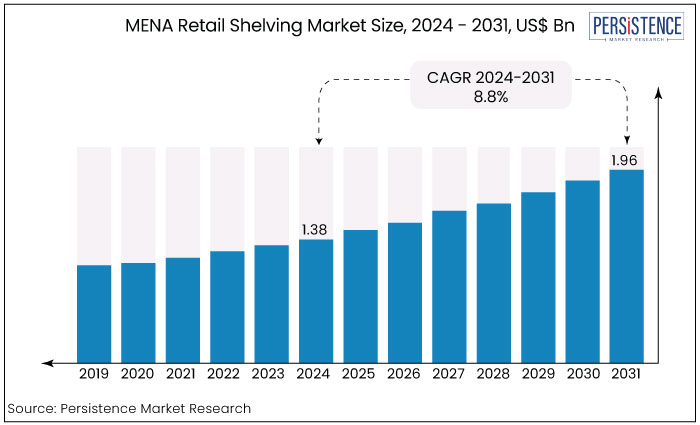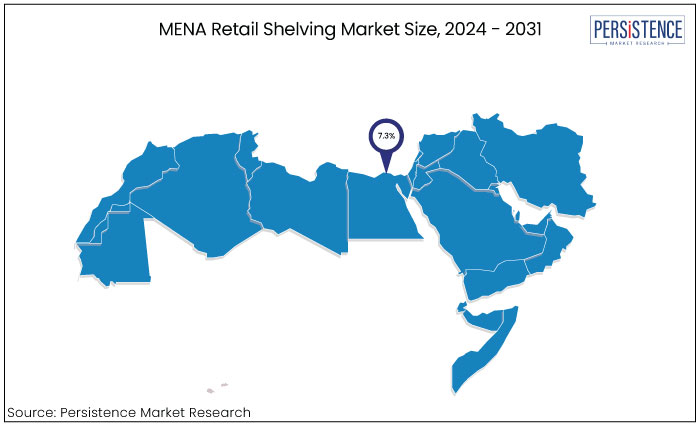Industry: Industrial Automation
Published Date: October-2024
Format: PPT*, PDF, EXCEL
Delivery Timelines: Contact Sales
Number of Pages: 177
Report ID: PMRREP34881
The MENA retail shelving market is estimated to increase from US$ 1.38 Bn in 2024 to US$ 1.96 Bn by 2031. The market is projected to record a CAGR of 8.8% during the forecast period from 2024 to 2031.
The booming tourism industry in the Middle East is spurring consumer spending, which is projected to support the retail sector. It is further estimated to bolster demand for both flexible shelving for seasonal events or pop-up stores and permanent heavy-duty shelves in supermarkets.
In May 2024, for instance, Spinneys, a popular supermarket chain based in Dubai, opened its first-ever standalone food hall in Dubai Mall. The Kitchen by Spinneys provides ready-made food items for takeaway as well as on-the-go consumption. Similar new launches by reputed players across MENA are anticipated to create new growth avenues.

Key Highlights of the Market
|
Market Attributes |
Key Insights |
|
MENA Retail Shelving Market Size (2024E) |
US$ 1.38 Bn |
|
Projected Market Value (2031F) |
US$ 1.96 Bn |
|
Global Market Growth Rate (CAGR 2024 to 2031) |
8.8% |
|
Historical Market Growth Rate (CAGR 2019 to 2023) |
7.3% |
|
Category |
Market Share in 2024 |
|
Material- Wood |
57.1% |
In the MENA retail shelving market, wood has consistently held the leading share in terms of material due to its high durability, aesthetic appeal, and versatility. Wooden retail shelving units are favored by retailers for their ability to create a warm and inviting shopping atmosphere, enhancing store aesthetics.
The natural look of wood complements various retail environments- right from upscale boutiques to grocery stores. Additionally, wooden display racks for retail stores offer excellent load-bearing capacity and can be customized to fit specific design needs. This makes it a practical choice for displaying a wide range of products. As retailers increasingly prioritize creating engaging customer experiences, demand for wooden shelving is expected to remain strong, solidifying its position.
The MENA retail shelving market is projected to witness robust growth owing to rapid expansion of the retail sector and evolving consumer preferences for enhanced shopping experiences. Retailers are increasingly investing in aesthetically pleasing and functional shelving solutions to improve store presentations and optimize space.
Trends such as the rise of e-commerce and omnichannel retailing are also influencing shelving designs. These are mainly prompting a shift toward flexible and modular systems that can adapt to various store layouts. Additionally, growing emphasis on sustainability is estimated to lead to a high demand for eco-friendly materials and designs. As the market continues to evolve, innovation and customization will likely be key differentiators for industry players.

The MENA retail shelving market witnessed substantial growth at a CAGR of 7.3% in the historical period from 2019 to 2023. This growth fueled by a thriving retail sector and rising consumer spending.
Rapid expansion of supermarkets, hypermarkets, and specialty stores significantly influenced this trend, creating a surging demand for visually appealing and functional shelving solutions. LuLu Group International, based in Abu Dhabi, for instance, has been broadening its presence across Qatar, Oman, and Saudi Arabia since the last few years. It also unveiled various hypermarkets in 2024 and announced its plan to open 91 more hypermarkets between 2023 and 2025. As retailers focus on enhancing customer experiences, the need for innovative shelving designs has become increasingly important.
The market is expected to maintain its positive trajectory, fueled by technological advancements and a growing emphasis on sustainability. Increasing significance of customer experience will also likely drive demand for customizable commercial retail shelving solutions that adapt to evolving retail environments.
Focus on Enhanced Store Presentations to Boost Demand
Improved store presentations are a key driver for the MENA retail shelving market growth. This is attributed to the gradual realization of retailers about the importance of creating visually appealing shopping environments.
Attractive store layouts often help enhance customer experience, encouraging longer visits and higher purchase rates. To achieve this, retailers seek customizable shelving solutions that align with their branding and merchandising strategies.
Retail store racks further allow for flexibility in design and functionality, enabling stores to adapt layouts based on seasonal promotions, product assortments, and consumer preferences. As retailers prioritize differentiation and engagement in competitive markets, demand for customizable shelving continues to rise, driving innovations and investments in MENA.
Desire for Aesthetics Spurs Demand for Retail Racking and Shelving Units
Store aesthetics is anticipated to significantly boost demand for customizable shelving solutions. Modern retailers are set to invest in the development of visually engaging environments to attract and retain customers.
An appealing store layout often enhances the entire shopping experience, leading to increased customer satisfaction and high sales. Customizable shelving allows retailers to tailor their displays to match branding, seasonal themes, and product categories. These also help in optimizing space while showcasing merchandise effectively.
As competition intensifies in the MENA retail sector, the focus on aesthetics becomes paramount. It will likely spur the need for innovative and versatile shelving options that cater to diverse retail strategies and consumer preferences.
Luxury Pricing of Retail Shelves May Hamper Adoption among Small Retailers
High-quality shelving solutions often come with substantial costs, posing a significant challenge for small-scale retailers operating on limited budgets. These retailers may struggle to invest in durable and aesthetically pleasing shelving that enhances their store presentations and customer experience.
They might also resort to low-quality or less visually appealing options, which can negatively impact their brand image and sales potential. This financial constraint can hinder their ability to compete with large-scale retailers that can afford advanced shelving systems. These factors are anticipated to limit sales and negatively impact the MENA retail shelving market revenue.
Lack of Immediate Financial Returns May Restrain Adoption
Cost pressure in competitive retail environments is a significant factor impeding investments in high-end shelving solutions. As retailers in MENA face intense competition, they are compelled to maintain low prices and maximize profit margins. This focus on cost efficiency often leads to budget constraints, limiting their willingness to invest in premium shelving units that enhance store aesthetics and customer experience.
Retailers may further prioritize immediate financial returns over long-term investments in quality shelving. They are set to opt for low-cost alternatives that lack the durability and visual appeal of high-end options. Consequently, this reluctance to invest in superior shelving solutions can hinder their ability to create engaging shopping environments. It is anticipated to impact their competitiveness and growth potential in a rapidly evolving retail landscape.
Emergence of Flexible Shelving Units to Meet Changing Demands Creates Opportunities
Flexible shelving solutions that can easily adapt to changing store layouts are set to present a significant growth opportunity in the MENA retail shelving industry. The need for adaptable shelving becomes paramount as retailers embrace dynamic strategies to meet evolving consumer preferences and seasonal demands. These versatile systems enable retailers to quickly reconfigure displays, optimizing space utilization and showcasing products effectively.
The trend toward omnichannel retailing also emphasizes the importance of flexibility in store design. By investing in customizable shelving that can be rearranged as needed, retailers can enhance customer experience and respond proactively to the latest trends, driving innovation in MENA.
Smart Shelving Units with Sensors and Displays to Boost Customer Retention
Smart shelving units equipped with sensors and digital displays are set to offer significant opportunities for retailers to differentiate themselves in the competitive MENA market. By integrating technology into shelving systems, they can enhance customer engagement and streamline operations.
Sensors can monitor stock levels in real time, allowing for automated inventory management and ensuring that popular products are always available. Digital displays can showcase promotions, product information, and personalized content. These are projected to help create an interactive shopping experience to retain consumers. This innovation not only enhances the aesthetic of the store but also fosters customer loyalty through tailored marketing efforts. As retailers increasingly seek to stand out in a crowded marketplace, adopting smart shelving solutions positions them to meet the demands of tech-savvy consumers.
The MENA retail shelving industry features a competitive landscape with various local and international players. Key companies include Mecalux S.A., Interroll Group, Averys Group, and Constructor Group AS. These players are currently offering diverse shelving solutions tailored to regional needs.
A few key firms compete with factors such as product quality, customization options, and pricing. As the market evolves, they increasingly focus on sustainability and innovative designs to attract retailers looking to enhance in-store aesthetics. Strategic partnerships and technological advances further drive competition, enabling businesses to meet the growing demand for flexible and visually appealing shelving solutions.
Recent Industry Development
|
Attributes |
Details |
|
Forecast Period |
2024 to 2031 |
|
Historical Data Available for |
2019 to 2023 |
|
Market Analysis |
US$ Bn for Value |
|
Key Countries Covered |
|
|
Key Market Segments Covered |
|
|
Key Companies Profiled |
|
|
Report Coverage |
|
|
Customization & Pricing |
Available upon request |
By Shelving Type
By Material
By Application
By Country
To know more about delivery timeline for this report Contact Sales

It is projected to surge to US$ 1.96 Bn by 2031 from US$ 1.38 Bn in 2024.
Interroll Group, Averys Group, Constructor Group AS, and Gondella International are a few manufacturers.
It includes a wide range of gondolas, retail fixtures, and display units to showcase merchandise in shops.
It refers to the process of evaluating how much space each product gets on shelves, how they are arranged, and where they are placed.
It is projected that the market would rise at a CAGR of 8.8% through 2031.